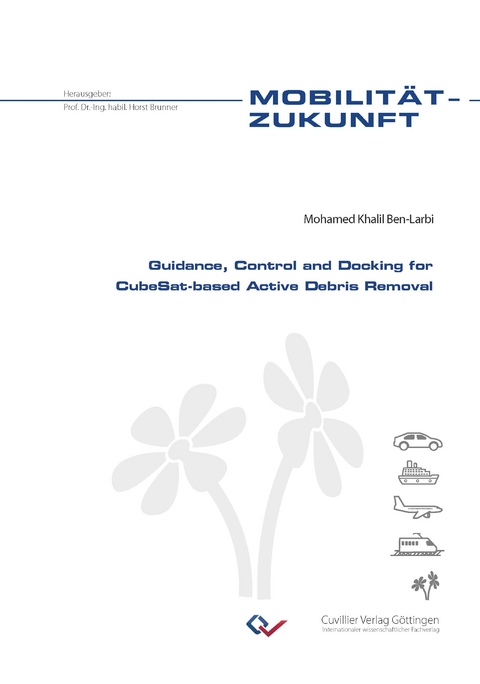Guidance, Control and Docking for CubeSat-based Active Debris Removal
Seiten
2023
Cuvillier Verlag
978-3-7369-7848-5 (ISBN)
Cuvillier Verlag
978-3-7369-7848-5 (ISBN)
https://cuvillier.de/de/shop/publications/8869-guidance-control-and-docking-for-cubesat-based-active-debris-removal
While a paradigm shift in space industry has already started involving “mass production” of higher standardized, large distributed systems such as constellations, there are no effective solutions existing for the “mass removal” of satellites. Many indicators point to a further increase in the space traffic in Earth orbit in the near future, which could imply new dynamics in the evolution of the space debris environment. Even in case of diligent compliance with the Inter-Agency Space Debris Coordination Committee (IADC) mitigation guidelines, the growth in space traffic complicates its management and drastically increases the probability of accidents and system failures. NASA scientist Donald J. Kessler proposed a scenario in which the density of objects in low Earth orbit is high enough that collisions between objects could cause a cascade that renders space unusable for many generations. Therefore, a reliable and affordable capability of removing or servicing non-functional objects is essential to guarantee sustainable access to Earth orbit. Recently, the CubeSat design standard introduced a new class of cost-efficient small spacecraft and thereby offers a potential solution to the active debris removal (ADR) problem. The development of a novel “CubeSat-compatible” ADR technology has significant advantages such as the use of commercial off-the-shelf parts, reduced launch cost, and reduced design efforts.
This thesis presents –in the frame of an ADR mission– an approach to advanced rendezvous and docking with non-cooperative targets via CubeSat. It covers the design process of simulation systems used for verification purposes, the ideation and implementation of novel guidance, control, and docking techniques, as well as their verification and evaluation. The outcome of this research is a series of validated software tools, processes, technical devices, and algorithms for automated approach and docking, that have been tested in simulation and with prototype hardware.
While a paradigm shift in space industry has already started involving “mass production” of higher standardized, large distributed systems such as constellations, there are no effective solutions existing for the “mass removal” of satellites. Many indicators point to a further increase in the space traffic in Earth orbit in the near future, which could imply new dynamics in the evolution of the space debris environment. Even in case of diligent compliance with the Inter-Agency Space Debris Coordination Committee (IADC) mitigation guidelines, the growth in space traffic complicates its management and drastically increases the probability of accidents and system failures. NASA scientist Donald J. Kessler proposed a scenario in which the density of objects in low Earth orbit is high enough that collisions between objects could cause a cascade that renders space unusable for many generations. Therefore, a reliable and affordable capability of removing or servicing non-functional objects is essential to guarantee sustainable access to Earth orbit. Recently, the CubeSat design standard introduced a new class of cost-efficient small spacecraft and thereby offers a potential solution to the active debris removal (ADR) problem. The development of a novel “CubeSat-compatible” ADR technology has significant advantages such as the use of commercial off-the-shelf parts, reduced launch cost, and reduced design efforts.
This thesis presents –in the frame of an ADR mission– an approach to advanced rendezvous and docking with non-cooperative targets via CubeSat. It covers the design process of simulation systems used for verification purposes, the ideation and implementation of novel guidance, control, and docking techniques, as well as their verification and evaluation. The outcome of this research is a series of validated software tools, processes, technical devices, and algorithms for automated approach and docking, that have been tested in simulation and with prototype hardware.
| Erscheinungsdatum | 15.08.2023 |
|---|---|
| Reihe/Serie | Mobilität-Zukunft ; 38 |
| Verlagsort | Göttingen |
| Sprache | englisch |
| Maße | 176 x 250 mm |
| Themenwelt | Technik ► Maschinenbau |
| Schlagworte | Active debris removal • Aeromechanische Plattform • Air bearing table • Aktive Weltraummüllentfernung • Astrobee • Betriebskonzept • Concept of operations • CubeSat, Space debris , Weltraummüll • Differential Drag • Differentieller Atmosphärischer Widerstand • Docking • Formation fight • Formationsflug • guidance and control • Guidance, navigation • Hardware-in-the-Loop Simulation • Internationale Raumstation • International Space Station • Kessler Syndrome • Kleinsatellit • Luftlagertisch • model-based systems engineering • Model-basierte Systemtechnik • Modeling and Simulation • Nicht kooperatives Ziel • Non-cooperative target • Relative Bewegng von Raumfahrzeugen • Relative Orbitalelemente • Relative orbital elements • rendezvous and docking • small satellite • Spacecraft relative motion • space debris priority list • Systems Engineering • Systemtechnik • Verification and Validation • Victor Glover • Weltraummüll Prioritätsliste |
| ISBN-10 | 3-7369-7848-0 / 3736978480 |
| ISBN-13 | 978-3-7369-7848-5 / 9783736978485 |
| Zustand | Neuware |
| Informationen gemäß Produktsicherheitsverordnung (GPSR) | |
| Haben Sie eine Frage zum Produkt? |
Mehr entdecken
aus dem Bereich
aus dem Bereich
Normung, Berechnung, Gestaltung
Buch | Softcover (2023)
Springer Vieweg (Verlag)
CHF 55,95
Buch | Softcover (2023)
Springer Vieweg (Verlag)
CHF 34,95
Buch | Softcover (2023)
Springer Vieweg (Verlag)
CHF 34,95




